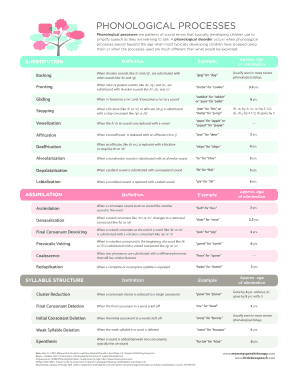
Phonological Processes Form


Understanding Phonological Processes
Phonological processes are systematic patterns of sound errors that children use as they develop speech and language skills. These processes help simplify speech as children learn to articulate complex sounds. Common phonological processes include vowelization, palatal fronting, and deaffrication, each with specific age ranges for expected elimination. Understanding these processes is crucial for parents and educators in identifying speech development milestones and potential areas needing intervention.
Steps to Complete the Phonological Processes
Completing a phonological processes assessment involves several steps to ensure accurate evaluation and support for speech development. First, observe the child's speech patterns to identify any recurring sound errors. Next, document specific instances of phonological processes, noting the frequency and context of errors. After gathering this information, consult with a speech-language pathologist for a comprehensive assessment. They will analyze the data and provide recommendations for targeted interventions to support the child's speech development.
Key Elements of Phonological Processes
Several key elements define phonological processes, including the types of sound substitutions and the age at which these processes typically diminish. For instance, vowelization often occurs when children replace consonants with vowels, while palatal fronting involves substituting sounds made in the back of the mouth with those made in the front. Understanding these elements helps caregivers and educators recognize normal speech development and identify when a child may need additional support.
Examples of Phonological Processes
Examples of phonological processes include common substitutions that children make during speech development. For instance, a child might say "wabbit" instead of "rabbit," demonstrating the substitution phonological process. Another example is "tat" for "cat," showcasing the deaffrication process. These examples illustrate how children simplify speech as they learn, and recognizing these patterns can aid in tracking speech development progress.
Legal Use of Phonological Processes
While phonological processes primarily relate to speech development, understanding their legal implications is essential in educational settings. Documentation of speech assessments may be required for special education services under the Individuals with Disabilities Education Act (IDEA). Accurate records of phonological processes can support eligibility for interventions and ensure compliance with legal requirements regarding speech and language services in schools.
State-Specific Rules for Phonological Processes
State-specific rules regarding phonological processes may vary, particularly in educational contexts. Each state has its guidelines for speech and language services, including eligibility criteria for special education. It is important for parents and educators to familiarize themselves with local regulations to ensure that children receive appropriate assessments and interventions based on their specific needs.
Quick guide on how to complete phonological processes age of elimination
Effortlessly prepare phonological processes age of elimination on any device
Digital document management has gained popularity among businesses and individuals. It offers an ideal eco-friendly substitute for conventional printed and signed documents, since you can obtain the correct template and securely store it online. airSlate SignNow provides you with all the tools needed to create, edit, and eSign your files promptly and without delays. Manage phonological processes on any device using airSlate SignNow's Android or iOS applications and enhance any document-centered process today.
How to edit and eSign phonological processes chart with ease
- Obtain vowelization phonological process and click Get Form to start.
- Use the tools we offer to complete your document.
- Highlight pertinent sections of the documents or obscure sensitive information with tools provided by airSlate SignNow specifically for that purpose.
- Create your signature using the Sign feature, which takes mere seconds and holds the same legal validity as a conventional wet ink signature.
- Review all the details and click on the Done button to save your modifications.
- Choose how you wish to send your form, whether by email, SMS, invitation link, or download it to your computer.
Say goodbye to lost or misplaced files, tedious document searches, or mistakes that require printing new copies. airSlate SignNow meets your document management needs in just a few clicks from any device of your choice. Edit and eSign phonological process chart and ensure excellent communication at any point in the document preparation process with airSlate SignNow.
Create this form in 5 minutes or less
Related searches to deaffrication age of elimination
Create this form in 5 minutes!
How to create an eSignature for the phonological processes by age
How to create an electronic signature for a PDF online
How to create an electronic signature for a PDF in Google Chrome
How to create an e-signature for signing PDFs in Gmail
How to create an e-signature right from your smartphone
How to create an e-signature for a PDF on iOS
How to create an e-signature for a PDF on Android
People also ask phonological processes vowelization
-
What are phonological processes and how can they affect my business's document management?
Phonological processes refer to the patterns of sound errors that can affect speech clarity, which may extend to misunderstandings in document management. Ensuring clear communication is crucial in efficient document handling. By utilizing airSlate SignNow, businesses can minimize the impact of such processes through clear electronic signatures and streamlined documentation.
-
How does airSlate SignNow simplify the eSigning process for documents related to phonological processes?
airSlate SignNow enhances the eSigning process by providing an intuitive platform that simplifies document signing. This is particularly beneficial when dealing with documents involving phonological processes, ensuring that all parties can clearly understand and complete transactions without confusion. The user-friendly interface makes it easy for all parties to sign documents promptly.
-
What pricing plans does airSlate SignNow offer for businesses focusing on phonological processes?
airSlate SignNow offers flexible pricing plans designed to fit various business needs, including those focusing on phonological processes. Each plan provides unique features that promote efficiency, making it a cost-effective solution regardless of your business size. You can choose from individual, team, or enterprise plans depending on your requirements.
-
Can I integrate airSlate SignNow with other tools to manage phonological processes effectively?
Yes, airSlate SignNow seamlessly integrates with various tools and software, enabling enhanced management of phonological processes. Whether you use CRM systems or project management tools, these integrations help streamline workflows and improve communication. This ensures that all documents related to phonological processes are easily accessible and manageable.
-
What are the key benefits of using airSlate SignNow for managing documents related to phonological processes?
The key benefits of using airSlate SignNow include improved efficiency, reduced errors, and enhanced clarity, specifically when managing documents related to phonological processes. The platform allows for secure eSigning and easy tracking, making it ideal for businesses aiming to increase productivity. This can lighten the burden of misunderstandings that hinder effective communication.
-
How secure is airSlate SignNow for handling sensitive documents involving phonological processes?
AirSlate SignNow employs advanced security measures to protect sensitive documents associated with phonological processes. This includes encryption and secure storage that comply with industry standards to safeguard your data. You can trust that your important documents are secure throughout the signing process.
-
Is airSlate SignNow suitable for small businesses needing to address phonological processes?
Absolutely! airSlate SignNow is designed to be cost-effective and user-friendly, making it a perfect choice for small businesses addressing phonological processes. The platform empowers small teams to efficiently manage document workflows without overwhelming costs or complex setups. It’s an ideal solution for enhancing operational efficiency.
Get more for phonological process vowelization
- Alabama landlord form
- Guaranty or guarantee of payment of rent alabama form
- Letter from landlord to tenant as notice of default on commercial lease alabama form
- Residential or rental lease extension agreement alabama form
- Commercial rental lease application questionnaire alabama form
- Al application form
- Al lease form
- Salary verification form for potential lease alabama
Find out other phonological patterns
- Sign New Hampshire Police Executive Summary Template Free
- Sign New Hampshire Police Operating Agreement Fast
- Sign New Hampshire Police Executive Summary Template Secure
- Sign New Hampshire Police Operating Agreement Simple
- Sign New Hampshire Police Executive Summary Template Fast
- Sign New Hampshire Police Executive Summary Template Simple
- Sign New Hampshire Police Operating Agreement Easy
- Sign New Hampshire Police Executive Summary Template Easy
- Sign New Hampshire Police Executive Summary Template Safe
- How To Sign New Hampshire Police Executive Summary Template
- Sign New Hampshire Police Operating Agreement Safe
- How To Sign New Hampshire Police Residential Lease Agreement
- How Do I Sign New Hampshire Police Executive Summary Template
- How Do I Sign New Hampshire Police Residential Lease Agreement
- Help Me With Sign New Hampshire Police Residential Lease Agreement
- How Can I Sign New Hampshire Police Residential Lease Agreement
- Help Me With Sign New Hampshire Police Executive Summary Template
- Can I Sign New Hampshire Police Residential Lease Agreement
- How Can I Sign New Hampshire Police Executive Summary Template
- Sign New Hampshire Police Purchase Order Template Online